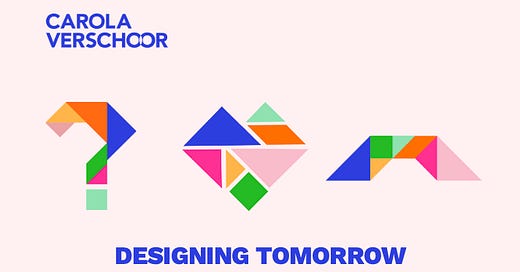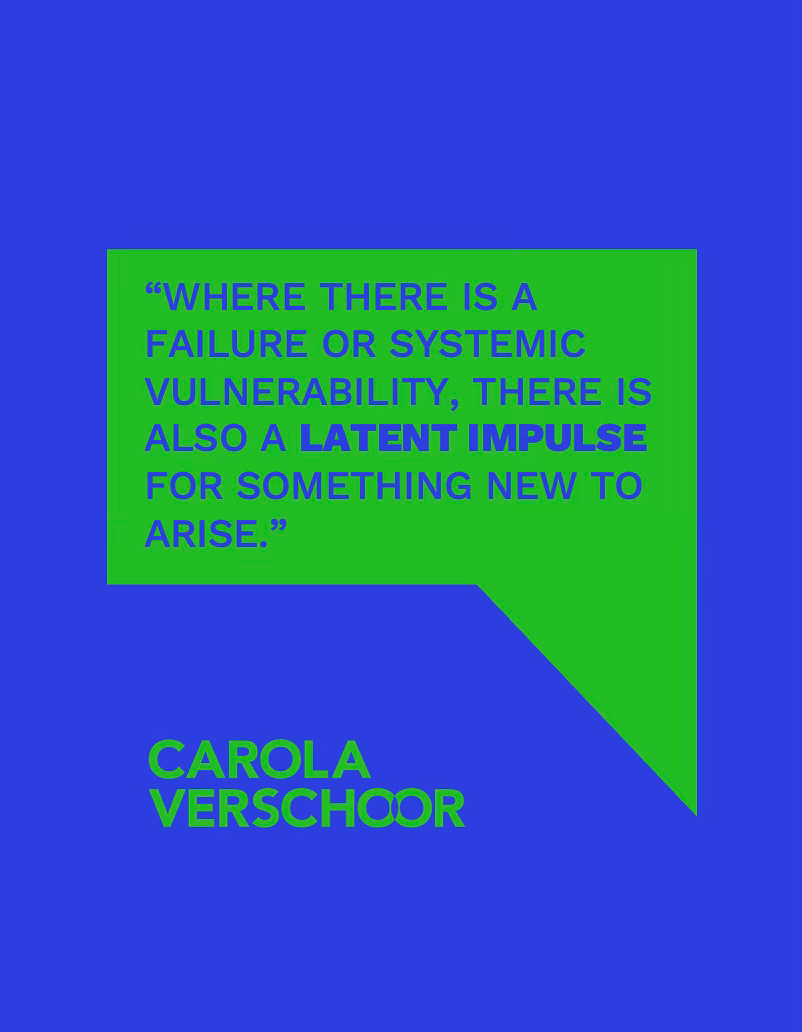Designing Tomorrow -beyond the Liminal
🌅Liminality brings uncertainty, challenging our collaborative ability. Profound transformation forms out of questioning what is, seeing fractures in our systems and building bridges to what might be.
TL;DR: Systemic collapse is everywhere, and the challenges it brings are opportunities for creativity and transformation. Embracing uncertainty and questioning assumptions can lead to collaborative solutions. Diverse perspectives are essential for navigating complexity and designing a better future. Profound transformation forms out of questioning what is, seeing fractures in our systems and building bridges to what might be.
Systemic collapse is ubiquitous. Whether it is the healthcare crisis, geopolitical instability, or climate change: multiple global crises are worsening one another to produce a sense of that the world is coming to an end. But with every end is also a beginning. In the in between, we hold the keys to designing tomorrow.
Accepting the end of what we know opens a space for not-knowing in which we can ignite our curiosity through questions and dialogue, spark our ingenuity through regenerative potential and enliven our craftsmanship and collaboration to build pathways to transformation.
Questioning Our Way Out of Liminality: Embracing the Not-Knowing as a Space for Creativity
In liminal periods, which are times of uncertainty and transition, we find ourselves suspended between the familiar and the unknown. This state of liminality can be disorienting, yet it also presents a unique opportunity for creativity and transformation. Embracing the not-knowing can be a powerful catalyst for change and (r)evolution.
Liminality is characterized by ambiguity and a lack of clear direction. In this space, traditional frameworks and established norms no longer apply. Confusion and curiosity lead to a renaissance of creativity. When we question our assumptions and challenge the status quo, we open ourselves to new possibilities. The act of questioning becomes a tool for exploration, allowing us to navigate the complexities of our environment.
To harness the creative potential of liminality, we must reframe our relationship with not-knowing. Instead of feeling lost, we can see the lack of answers as a fertile ground for ideas to germinate. By asking open-ended questions, we invite diverse perspectives and insights that can lead to innovative solutions. For instance, rather than seeking immediate answers, we can explore generative questions and approach challenges with a beginner’s mindset. Asking ourselves: What if we approached this challenge from a completely different angle? What assumptions are we making that may no longer hold true? How would we experience this if we were seeing it for the first time? Approaching things free of any assumptions, preconceptions, biases, ready made solutions or prior judgements.
Questioning is instrumental to collaboration and dialogue. In liminal spaces, individuals often feel isolated in their uncertainty. By creating environments where questioning is encouraged, we can build communities of inquiry. These communities can serve as incubators for creativity, where individuals feel safe to share their thoughts and ideas without fear. Through collective questioning, we can uncover hidden opportunities for each other and collaboratively generate all manner of transformations.
Taking the time to pause and reflect on our experiences can deepen our understanding of the challenges we face. Reflection allows us to identify patterns, recognize emerging trends, and gain clarity amidst the chaos. By integrating reflection and sharing into our creative processes, we enhance our ability to navigate uncertainty and emerge stronger on the other side.
Questioning our way out of liminality is the breakthrough creativity needs for transformation. By embracing the not-knowing, we break the known so that we can work our way through. Honouring that creativity thrives in ambiguity, and through questioning, we can illuminate the path forward.
The Fractures in Our Systems: Finding Opportunity in the Cracks
Our social, economic, and environmental systems are fraught with fractures. These fractures expose underlying issues, yet also present unique opportunities for transformation. Recognizing what has become obsolete or even counterproductive is critical, because where there is a failure or systemic vulnerability there is also a latent impulse for something new to arise. If things aren’t working it’s because we need something else to work.
The cracks in our systems reveal the limitations of existing structures and highlight entry points for exploration, reimagining and creativity. Looking deeply into the issues is painful and confronting. These fractures are present in the very heart of things: it’s heartbreaking. But confront ourselves we must, or we will face the consequences sooner or later.
All systems fail, sooner or later: entropy creeps in and we are faced with the unintended consequences. This happens because as the world becomes more and more complex we cannot know in advance how things will interact and unfold. It’s practically impossible to anticipate the full impact of anything, which so much going on. But we can learn from our mistakes by reviewing the design principles and analysing the root causes of the issues that emerge. Who is affected by them? What alternative approaches could address these challenges? More often than not, they are different when we look deeper than when we take a first look. Because really looking involves going beyond the obvious. Pausing and shifting perspective.
Moreover, the fractures in our systems often expose the experiences of marginalized communities and individuals. Marginality quite simply means: being at the fringes, at the margins of our systems. By amplifying these voices, we enrich our understanding of the systemic issues at hand and the design variables that need to be included for transformation to make sense and be relevant. Informed by diverse perspectives and experiences that give shape to the whole.
Experimentation and learning are the pathways to testing our assumptions, prototyping new ideas, experiencing what the future might feel like and iterating our solutions, ultimately leading to better and sustainable outcomes.
Curiosity, inclusivity, and initiative allow us to see the cracks in our systems as openings to a new and transformed world rather than as threats to systems that are no longer working.
Designing tomorrow requires learning from yesterday and letting go of what we feel certain of today. So that we can create with a fresh and regenerative impulse, born from our imagination of all that can be.
Building the Bridge as We Walk on It: The Power of Co-Creation and Collaboration for Transformation
Building a bridge to a transformed future requires collective effort and shared vision. As Bruce Mau so wonderfully expresses in his brilliant book MAU24: “New wicked problems demand new wicked teams.” We cannot face complex problems without a diversity of talents that come together to co-create.
Co-creation involves bringing together diverse perspectives, skills, and experiences to collaboratively design solutions. In liminal times, where traditional approaches may falter, co-creation allows us to tap into the collective intelligence of a group of individuals with a diversity of talents and perspectives. When people contribute to understanding and unravelling the problem, solutions are relevant, inclusive, and responsive to the needs of all.
Each participant brings unique insights and ideas, enriching the creative process. Collaboration, dialogue and making things together enhances a sense of belonging and connection, creating a shared commitment to the transformation process. When we hold space for honest dialogue and constructive feedback, solutions are ultimately more robust.
Like building bridges in the real world, co-creation requires flexibility and adaptability. The best bridges are not static, for they would break. They are in dynamic interaction with their environment. Facing the complexities of transformation, requires flexibility too. Groups are better in being responsive to emerging issues and challenges. To iterate ideas and embrace the dynamics of change. This iterative process allows us to learn from our experiences, refine our solutions in real-time and gather intrinsic strength through the collective interaction of talents.
Trailblazers of Tomorrow
Trailblazing requires entering uncharted territory and creating new paths towards transformed systems and a better, kinder and more prosperous world. Courage to let go of the past, perspective for identifying future opportunities, and collaboration in navigating complexity and overcoming challenges in today's world, requires diverse teams. Because we need strong, sustainable solutions. Building resilience is a team effort. Speed and efficiency must make way for intentionality and integrity. Or we will keep on walking the beaten path. And that is leading us absolutely nowhere, fast.
As the African proverb goes: “if you want to go fast, go alone; if you want to go far, go together.” Feeling deeply into the questions that emerge from liminality, accepting our brokenness and building bridges towards the unknown will help us blaze trails towards transformation.






